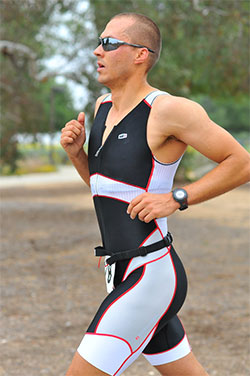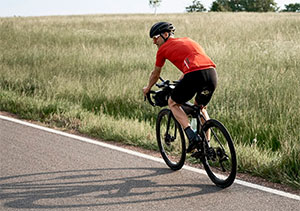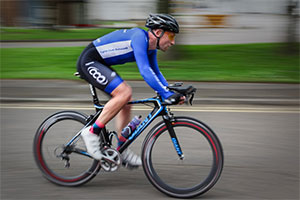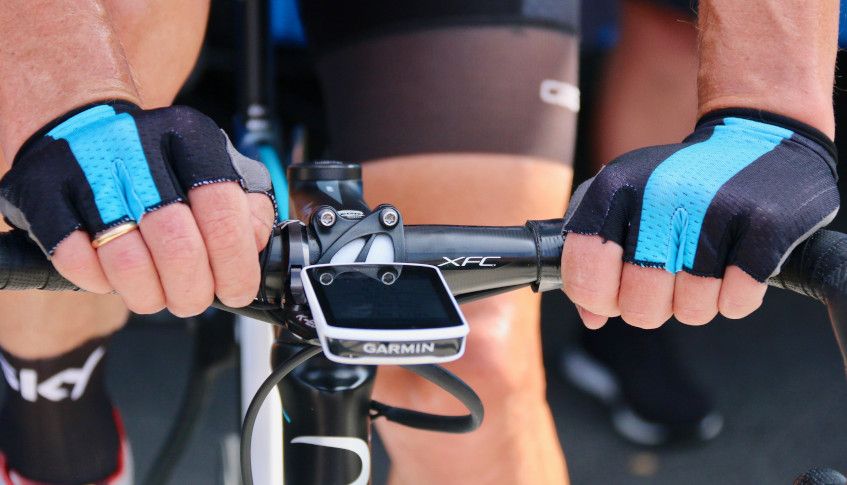Heart zone training is a confusing concept for many cyclists. It does not help that most of the information available online is complicated. This is frustrating for bike riders who want to try it. Heart zone training opens a whole new world of health benefits, even for the average cyclists.
In this guide, you will learn the ins and outs of heart zone training in a simplified language. You will no longer train using too much effort and get minimum results—and probably hurt yourself in the process. Cycling will be much more productive for you.
Key Takeaways
- Heart zone training is a form of training that uses your heart rate to guide the intensity of your exercises.
- There are five heart zones, each with different benefits and challenges. You can calculate your target heart rate for each zone using a simple formula or a calculator.
- Heart zone training can help you improve your fitness, endurance, fat burning, oxygen intake, and lactic acid clearance.
- You should follow a workout schedule that balances the time and intensity of each zone according to your goals and abilities.
- Consult your doctor before doing high-intensity exercises.

licensed under CC BY-SA 2.0
What is Heart Zone Training?
Basically, heart zone training is a form of training in which your heart rate (HR) guides the intensity of your exercises.
Your heart rate is the number of heart beats per minute (bpm).
So using your HR, you regulate your workouts such that you use a certain amount of effort for a specified duration.
Resting Heart Rate and Maximum Heart Rate
Your heart has a resting heart rate and a maximum heart rate (MHR). The MHR is the highest number of heart beats per minute that your heart can beat. The resting heart rate is the number of heart beats per minute when you are well rested.
Establishing your MHR can be a challenging task. It requires pushing yourself to the maximum; which can be dangerous.
The simplest method for knowing your MHR is the age-based method. It is as simple as subtracting your age from 220 or using this formula: 208 – (0.7 x your age). The resulting number is your MHR.
The simplest method for knowing your Maximum Heart Rate (MHR) is the age-based method. It is as simple as subtracting your age from 220 or using this formula: 208 – (0.7 x your age). The resulting number is your MHR.
For example, if you are 30 years old, your estimated MHR will be 190 (220 – 30).
There are many factors that make this method inaccurate such as the fitness of the cyclist. For a more accurate figure, visit a physician. They will perform a stress test on you and give you a more reliable number.
The resting heart rate is easier to determine. You are most relaxed when you wake up in the morning. Place two fingers (your index and middle fingers) on your neck, right below the jaw and count the beats per minute. Do this for a few days and find the average.
Training Zones
Generally, training zones are percentages of your maximum heart rate and are found between the resting heart rate and the MHR.
In most cases, they are five:
| Zone | Effort | Heart rate |
| Zone 1 | Active Recovery | 50 – 60% of your MHR |
| Zone 2 | Endurance | 60 – 70% of your MHR |
| Zone 3 | Tempo | 70 – 80% of your MRH |
| Zone 4 | Lactate Threshold | 80 – 90% of your MRH |
| Zone 5 | VO2Max | 90 – 100% of your MRH |
Do not let the numbers intimidate you. This is easy math. The idea is to exercise until you get into a certain zone, that is, attain a certain percentage of the MRH, then maintain the intensity.
Zone 1: Active Recovery Zone
What it is: This is the least intense zone, characterized by easy exercises.
Benefits:
- Promotes recovery
- Rids the body of metabolic by-products
- Reduces risk of cardiovascular disease
- Enhances blood circulation
- Burns fat
Otherwise known as the healthy heart zone, this is the most comfortable one compared to the other four. It entails very light training. Your heart rate will be at 50-60% of your MRH.
As the name suggests, you cross-train or ride lightly to encourage recovery—mainly from an intense workout session. The last thing you want to do here is stress your body. The low intensity should promote the body to get rid of metabolism by-products such as lactic acid and transport oxygenated blood to your worn out muscles.
Cycle in this zone if your previous workout was intense and you are feeling a little sore. Alternatively, incorporate this zone between intervals so you can catch your breath.
A good way to ride in this zone is to take your bike out on a sunny day. Avoid hilly terrain and just cycle leisurely. Using a bike trainer is a great option too—especially because it is easier to check your parameters. You should be able to talk comfortably.
Although this zone feels easy, it burns the most fat.

Zone 2: Endurance
What it is: This is the second most comfortable zone. While you can hold a conversation, you will strain a little.
Benefits:
- Improves general performance
- Facilitates fat utilization
- Clears lactic acid
- Enhances energy efficiency
- Boosts mitochondria levels
This is the zone that you should train in most of the time. It is not very different from the active recovery zone but the intensity is definitely higher. You can still talk but not as effortlessly as you could in zone 1. Consequently, you will be burning a lot of fat.
There is a reason why every cyclist—beginner or pro—should learn to spend a considerable amount of time in the endurance zone. One benefit is that it causes the body to use fat for energy as opposed to glycogen. Your body stores way more fat than it does glycogen.
Training in zone 2 properly will prepare you for races. At the beginning of the race, you will be using fat and only save glycogen for the end—where you will need it the most.
Another benefit of this zone is that the body learns to clear lactic acid whenever it is produced. When you exercise, lactic acid is produced as a by-product. If it is not cleared, your muscles “burn” and you may be forced to cycle more slowly.
While in this zone, be careful not to get into zone 1 or go higher to zone 3. It happens.

Zone 3: Tempo
What it is: It is also known as the transition zone—it takes you from the comfortable to the uncomfortable ones.
Benefits:
- Builds endurance
- Repairs blood vessels
- Improves lung and heart capacity
- Enhances your frame
- Increases strength of the heart muscle
This is the aerobic heart rate zone. Now things are getting intense. Your heart should be beating at 80-90% of your maximum heart rate. As the exercise gets vigorous, you can barely speak long sentences. It is a difficult zone but the kind of difficult that is still comfortable.
There is a lot of debate concerning zone 3. Experts cannot agree on whether or not cyclists should spend a lot of time here. When preparing for long-distance races, try to spend significant time in this zone to build endurance.
The intensity applied here helps in the repairing of blood vessels. It also boosts your lung and heart capacity. This is the zone that makes you fit and gives you that frame that you have been desiring.
Zone 3 is usually achieved when doing “sweet spot workouts”. The intensity of these workouts is towards the top of the range. The sweet spot best balances the benefits attained with the recovery time.
Zone 4: Lactate Threshold
What it is: Your body will be straining here since you are getting closer to the maximum heart rate.
Benefits:
- Improves lactate threshold power
- Burns calories
You will be using up less fat and more carbohydrates here in the anaerobic heart rate zone. However, it is still an important zone for all cyclists.
Zone 4 will really stress your body. In fact, a good number of pro cyclists do not spend much time here. Other experts have been known to discourage it. Avoiding it altogether is a bad idea. The best thing you can do is use intervals because you cannot sustain the intensity of this zone for a long time.
As you go harder, more lactic acid is produced which makes riding more challenging. The anaerobic heart rate zone teaches your body to keep going even when you are getting tired.
Do not be tempted to overdo zone 4. It can wear you out, making it impossible to continue riding consistently.

Zone 5: VO2Max
What it is: This is the hardest you can go and the most challenging.
Benefits:
- Improves oxygen consumption at high intensity
- Burns highest number of calories
This is the top zone; the one that really tests your mettle. In case you are wondering, VO2 simply refers to oxygen intake and VO2Max is the maximum.
Exercises in this zone are extremely hard and uncomfortable. It is best for sprint and interval training.
The main purpose of this zone is to train your body to consume oxygen when the intensity is very high. Again, you cannot ignore this zone if you are training for a race. You will need the capabilities.
This zone requires that you push your body beyond its limits. While you will be doing it in intervals, you should talk to your doctor first.
Determine your Target Heart Rate Zone
Use the calculator to determine your target heart rate for your desired training zone.
Target Heart Rate Calculator
Understanding what your target heart rate should be is easier now that you know the basics. Your age and your resting heart rate are the biggest determinants here.
This method is very simple as you will see. Here is the formula:
Step 1: Subtract your age from 220 to get your maximum heart rate (MHR).
Step 2: Calculate your heart beats per minute when you are calm and rested to get your resting heart rate (RHR). Use a timer.
Step 3: Subtract your resting heart rate from your maximum heart rate to get your heart rate reserve (HRR). Then:
- Multiply the heart rate reserve with the minimum percentage of your target heart zone. Add the resulting number to your resting heart rate.
- Multiply the heart rate reserve with the maximum percentage of your target heart zone. Add the resulting number to your resting heart rate.
Going with this formula, you will have two numbers; one from the maximum percentage and another one from the minimum percentage. The lower number is the minimum number of heart beats for that zone. The higher number is the maximum.
For instance, if you want to know your target heart rate for Zone 1, you will use 50% as the minimum percentage and 60% as the maximum percentage.
Note: convert the percentages to decimal numbers to make the calculation more straightforward. 50% becomes 0.5, 60% becomes 0.6, etc.
Maybe a real life example will make this easier.
Example
Suppose you are 24 years old and your resting heart rate is 70. Here is how you would calculate your target heart rate for Zone 1.
Step 1: 220 – 24 = 196 (This is your maximum heart rate)
Step 2: You have determined that your resting heart rate is 70.
Step 3: 196 – 70 = 126 (This is your heart rate reserve)
- 126 x 0.5 = 63, then add 70. You get 133. This is the minimum number of heart beats per minute.
- 126 x 0.6 = 75.6, then add 70. You get 145.6 (round off to 146). This is the maximum number of heart beats per minute.
So for Zone 1 – Active Recovery Training, your target heart rate zone is 133 to 146 beats per minute.
Use this method for all the zones. Their percentages are shown above. Alternatively, use the calculator above and avoid the math. It uses the same formula.
Also read: How many Miles should I Bike a day?
Putting This Knowledge into Use
In as much as you are excited to try out heart zone training, you cannot just get on your trainer or bike and start mixing up zones.
There are tons of workout timetables or schedules online. They offer guidance and help you exercise safely and efficiently. Tom Bell offers a free workout handbook solely for this.

What Equipment to Use
When it comes to checking your pulse, your fingers will work. However, it will be very challenging once you start doing more vigorous workouts. Lucky for you, there are mobile apps for this.
For convenience and accuracy, invest in a heart rate monitor.
You can get a simple monitor or a fancy one that does more than just check your HR. It all depends on your budget.
If you have a smart trainer already, you may not need these gadgets.
Conclusion
Heart zone training appears complicated when you do not understand it.
However, you can see from this guide that it is all about mastering a few concepts.
The most important one is the maximum heart rate. From there, you can use your calculator to know your zones.
Then find a workout schedule and start training.
It is advisable that you consult your doctor especially because of zone 4 and zone 5. Let them tell you whether or not your heart can take it.

